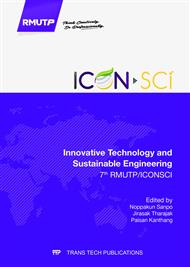[1]
A. Thuault, E. Savary, J. Moreau, M. Descamps, S. Marinel and A. Leriche, Improvement of the Hydroxyapatite Mechanical Properties by Direct Microwave Sintering in Single Mode Cavity, Journal of the European Ceramic Society, 32 (2014) 1865-1881.
DOI: 10.1016/j.jeurceramsoc.2013.12.035
Google Scholar
[2]
V. S. Viviane, S. L. Fernando and Z. D. Rosana, Microstructural and Mechanical Study of Zirconia-Hydroxyapatite (ZH) Composite Ceramics for Biomedical Applications, Composites Science and Technology, 61 (2001) 301-310.
DOI: 10.1016/s0266-3538(00)00222-0
Google Scholar
[3]
V. S. Viviane, S. L. Fernando and Z. D. Rosana, Synthesis and Characterization of Calcia Partially Stabilized Zirconia-Hydroxyapatite Powders Prepared by Co-Precipitation Method, Ceramics International, 27 (2001) 615-620.
DOI: 10.1016/s0272-8842(00)00122-x
Google Scholar
[4]
K. Hae-Won, L. Seung-Young, B. Chang-Jun, N. Yoon-Jung, K. Hyoun-Ee, K. Hyun-Man and K. Jea Seung, Porous ZrO2 Bone Scaffold Coated with Hydroxyapatite with Fluorapatite Intermediate Layer, Biomaterials, 24 (2003) 3277-3284.
DOI: 10.1016/s0142-9612(03)00162-5
Google Scholar
[5]
A. Rapacz-Kmita, A. Sloarczyk, Z. Paszkiewicz and C. Paluszkiewicz, Phase Stability of Hydroxyapatite-Zirconia (Hap-ZrO2) Composites for Bone Replacement, Journal of Molecular Structure, 704 (2004), 333-340.
DOI: 10.1016/j.molstruc.2004.02.047
Google Scholar
[6]
V. V. Silva and F. S. Lameiras, Synthesis and Characterization of Composite Powders of Partially Stabilized Zirconia and Hydroxyapatite, Materials Characterization 45 (2000) 51-59.
DOI: 10.1016/s1044-5803(00)00048-6
Google Scholar
[7]
P. Pankaew, E. Hoonnivathana, P. Limsuwan and K. Naemchanthara, Temperature Effect on Calcium Phosphate Synthesized from Chicken Eggshells and Ammonium Phosphate, Journal of Applied Sciences 10 (2010) 3337-3342.
DOI: 10.3923/jas.2010.3337.3342
Google Scholar
[8]
V. Santos, M. Zeni, C. P. Bergmann and J. M. Hohemberger, Correlation between Thermal Treatment and Tetragonal/Monoclinic Nanostructured Zirconia Powder Obtained by Sol-Gel Process, Advanced Materials Science, 17 (2008) 62-70.
Google Scholar
[9]
W. Sinh-Ching, H. Hsueh-Chuan, H. Shih-Kuang, C. Ya-Chu and H. Wen-Fu, Effects of Heat Treatment on the Synthesis of Hydroxyapatite from Eggshell Powders, Ceramics International, 15 (2015) 935-958.
Google Scholar
[10]
R. R. Ramachandra and T. S. Kannan, Synthesis and Sintering of Hydroxyapatite-Zirconia Composites, Materials Science and Engineering, 20 (2002) 187-193.
DOI: 10.1016/s0928-4931(02)00031-0
Google Scholar
[11]
K. Rajendra and P. Cheang and K. A. Khor, Radio Frequency (RF) Suspension Plasma Sprayed Ultra-Fine Hydroxyapatite (HA)/Zirconia Composite Powders, Biomaterials, 24 (2003) 2611-2621.
DOI: 10.1016/s0142-9612(03)00066-8
Google Scholar


